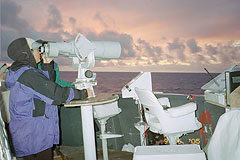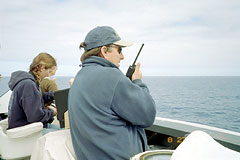

 | |||||||
|
|
Journals 2005/2006Maureen Barrett
August 27, 2005 We had two great sightings today. First, a group of Risso's dolphins (Grampus griseus) appeared soon after lunch. Risso's dolphins have no beak, and their dorsal fin is tall and erect. The scientific name griseus means "grizzled, mottled with gray" referring to the color of the body. There were about six in the group, included a cow and calf! A little while later, a blue whale surfaced. This was our third blue whale sighting on the cruise. The whale stayed close to the ship giving us some great photo opportunities. Having my binoculars in hand, the large splashguard and two blowholes were easily seen. Annie was really pleased to get pictures of the dorsal fin from both the left and right side of the animal. This required some skillful navigation from Officer Doug Krause who was on duty on the bridge. The zodiac was eventually launched, but the scientists did not have much success staying with the whale. Within less than a two hour period, we had about ten resightings. The whale surfaced for air approximately every ten minutes. Each time it surfaced, the new location was entered into the computer. All of the sightings were within a one square mile area making it much easier for us to keep a close eye on the whale. I spend many hours on the flying bridge every day because I don't want to miss any sightings! This gives me an opportunity to talk with the scientists and learn more about this line of work. It is extremely apparent that they are very passionate about their professions. After Annie got the photos she wanted of the blue whale, she was thrilled. Annie is a marine biologist for Cascadia Research in Olympia, Washington. Cascadia has the photo id catalog for blue whales in the north Pacific, so she was very pleased to get good dorsal fin photos. Individual blue whales can be determined by the dorsal fins. Annie is currently a research assistant and is also a Cascadia Research board member. She hopes to publish her first paper soon on the presence/absence of remora fish on blue whales. Annie enjoys writing and working in the field. She is also involved in the mammal stranding network in Washington and Oregon. Annie is contracted by NOAA to do four legs of this CSCAPE project. My bunkmate, Laura Morse, is contracted by NOAA for six legs of CSCAPE. When I first came on board the Jordan last week, Chief Scientist Susan Chivers took me to my stateroom. Laura was not on board at the time, but she had written me a welcome letter, had my linens on my bunk, and even had an origami swan on the desk. She made me feel extremely welcome, just like the rest of the scientists and crew members have been doing this entire cruise. This is Laura's seventh mammal survey with the Southwest Fisheries lab. As a marine mammal field biologist, Laura has traveled quite a bit, identifying and collecting data in Alaska, Antarctica, Norway, Cambodia, Florida, and the Bay of Fundy. For those of us on the east coast of the US, Laura has been involved in a right whale project for ten years now. Laura thoroughly enjoys being on the ocean and in the field. I was extremely impressed with Laura's "life list" of marine cetaceans. Out of the approximately 80 marine cetaceans in the world, Laura has 60 of them on her list!
Jim Gilpatrick is one of the mammal observers on board that works fulltime for NOAA Fisheries. He started with NOAA in 1979 as a tuna/dolphin observer on tuna fishing boats. I really did not know anything about the tuna industry, except reading that dolphins sometimes get caught in the tuna nets. Jim explained that tuna tend to follow dolphin in the eastern tropical Pacific, so catching only the tuna may be problematic for the fishery. I will now pay more attention to the tuna advertised as "dolphin safe" tuna! After Jim's work with the tuna/dolphin fishing boats, he worked in the lab as a research assistant analyzing data on dolphin populations, studying geographically isolated populations of spotter and spinner dolphins. Jim has done a great deal of aerial survey photography work in the eastern tropical Pacific. Survey work, like the CSCAPE project and other similar marine mammal surveys, is mandated by Congress since the passing of the 1972 Marine Mammal Protection Act.
It is really fascinating talking with the scientists about their work and learning about the variety of marine studies being conducted all over the world! |
||||||

